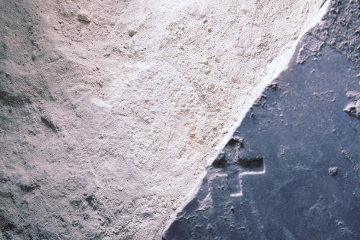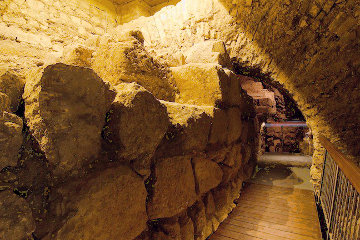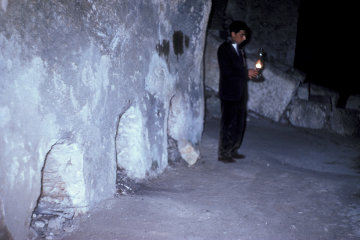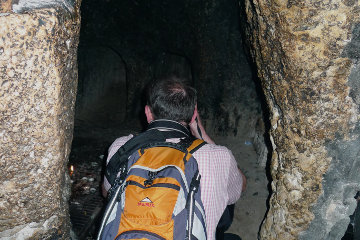The Date's Correct ...
The scandal of the Church of the Holy Sepulchre has been going on for centuries - for one of the most ridiculous manifestations, see the Wikipedia article "Immovable Ladder" which has been stuck up on a window ledge for nearly three centuries because the denominations which share ownership of the church cannot agree who should remove it or even whether it should be removed! Indeed, on our first visit to Jerusalem in 1958 the Muslim Jordanian Tourist Policeman told us of how he had been required to separate two groups of Christians (so-called) who were rioting inside the church over some minor grievance.

| |
| The steel frame surrounding the Edicule, which was erected by the British in 1947. |
For years the Edicule, the ornate structure that houses the actual tomb, has been in need of repairs, but agreement over what was necessary, who was to do it, and who was to pay for it, proved impossible to reach. Even the British, during their mandate over Palestine, were unable to persaude the warring factions to agree and the best they could do was enclose the Edicule in a cage of iron girders that supported the walls and prevented them bulging outwards and collapsing.
It took the Jews to knock heads together and make the different parties see sense. In 2015 the Israeli Antiquities Authority declared that the Edicule was a hazardous structure and sent in the police to close it, on the ground of public safety. Priests and monks were forbidden to enter and carry out their normal rituals; even worse, pilgrims, whose piety leads to substantial income for the churches, were forbidden to enter.
Faced with this threat to their pockets, the Roman Catholic, Greek Orthodox and Armenian Apostolic finally put aside their foolish squabbling and agreed a programme of works. The marble cladding, which has remained in place and untouched since at least 1555 was removed, the structure beneath was repaired and strengthened and then the marble was replaced.

| |
| Beneath the modern white marble slab was this much older blue marble with a cross incised in it. It was from beneath that the plaster dating from Queen Helena was taken. |
While they were at it, the workmen did the same for the shelf which is supposed to be the actual tomb - or rather, the very spot on which the body of Christ was laid or beneath which the body was laid. Beneath the shelf they found dirt which was coyly described as "fill material", and beneath that was a limestone slab or possibly limestone bedrock, which was widely hailed as the actual spot of Christ's burial.
Whether that is so, or not, is open to debate. There is considerable disagreement about the precise line taken by the Roman walls of Jerusalem. Many years ago we were shown in the nearby Lutheran church a stone wall that was claimed to be the city wall - which, if true, would show that the Holy Sepulchre is indeed outside the city walls. This is significant because in Roman times burials were not allowed inside a city and in any case, the Bible states that Jesus was buried in a garden. In a crowded city like Jerusalem, that is almost proof that the tomb was outside the city.

| |
| These ruins beneath the Lutheran Church of the Redeemer in Jerusalem are claimed to be of the eastern wall of the city. |
Unfortunately the Lutheran wall is not convincing as a city wall designed to keep enemies at bay. So far, at least, the claim that the Holy Sepulchre site is outside the city walls is a matter of faith, not fact.
The real problem is that Jerusalem was destroyed in AD 70 and its site was reduced to ruins. This was compounded after the Bar Kokhba revolt, when not only was the city destroyed again, but its inhabitants were exiled and for over a century Jews were forbidden to even come within sight of Jerusalem. Whether that ban extended to Christians - who were not involved in the revolt but who were a persecuted group - is not certain, but it is highly likely that no one could pinpoint the site of Christ's tomb because his father told him and had it from his father who had it from father - and so on.
Even if the general location could be known - on the east side of the city, so many paces from the city wall - the exact spot could not because Hadrian ordered a temple to Venus to be built in the area. Whether he did it to spite the Christians or simply because it was a conveniently level spot, we do not know. What is certain is that the temple was large enough to cover not only the tomb of Christ (if it was in that area) but numerous other tombs as well.
The tomb remained buried beneath this temple until Constantine made Christianity the official religion of the Roman empire and his mother, Helena, decided to visit Jerusalem and see the places associated with her faith. When she enquired for the tomb of Christ, the local Christians pointed to the site of the temple of Venus and the scandalised empress ordered that it be demolished at once, which was done.
When the stones were cleared away, a tomb was found. I am certain that several tombs were found and it is not clear on what basis one particular one was seized upon as the actual tomb of Christ. Nevertheless, it was chosen and the empress had its surroundings cleared - that is, the rock around the tomb was chipped away to leave a flat area in which the tomb stood proud.
Interestingly, you can see something similar in Corinth, where Glauke's Fountain, which featured in the myth of Jason and Medea, was given the same treatment. What may once have been a rocky knoll was reduced to a neatly squared block of stone out of which flowed the water of the fountain.
It would seem that the tomb remained in the open air, surrounded by a circular colonnade, and stayed that way until 1009 When the mad Egyptian caliph, al-Hakim, ordered that the church be destroyed. His workmen arrived and attacked the venerable stone block with hammers, shattering it to pieces. (There has always been an anti-Christian strain within Islam, despite the injunctions in the Qur'an that Muslims should live in peace with other "people of the Book".)
Nineteen years later, with al-Hakim safely vanished, his son allowed the church to be rebuilt and it was discovered that the workmen had simply knocked down the stone until the whole site was buried. When the fragments of stone were cleared away, the outline of the original tomb was discovered a foot or more high and it is this outline which was built up to form the Edicule of today.

| |
| A young man holds a lamp inside the claimed tomb of Haggai and Zachariah. Note the kokhim in the wall. |
All this is very interesting, but from the archaeological point of view, puzzling. During the late first century BC and down to the destruction of Jerusalem in AD 70 Jews in Palestine adopted a distinctive mode of burial. A tomb consisted of an underground room; at floor-level around the walls of this room a number of short, coffin-sized tunnels (called kokhim) were excavated. When the owner of the tomb died, his body was placed in one of these tunnels, which was then blocked up. A year or so later the blocking was removed. By that time the body had decayed away leaving just the bones behind, which were revently gathered up and placed in a stone box known by its Latin name of ossuary or "bone box".
There are numerous such tombs dotted around Jerusalem. The Tomb of Herod (though inaccessible now) was one, so are the Tombs of the Sanehdrin, the Tombs of the Kings, and so on. The problem is that the tomb in the Church of the Holy Sepulchre does not conform to this type (neither does the Garden Tomb). Whether it dates to a later period or, like the Garden Tomb, is typical of an earlier period, I cannot say and I don't think the recent investigations show.

| |
| A member of my tour group photographs the kokhim in the Chapel of St Nicodemus, visible beyond him. |
Ironically, behind the Edicule there is a dusty and little-used rock-cut room known as the Chapel of Nicodemus and opening off it is another room in which are two perfect kokhim. If the tomb of Christ is anywhere within the structure of the Church of the Holy Sepulchre, I believe it is one of these first century AD kokhim. The first time I saw them they were half filled with dirty water on which a couple of cigarette butts floated.
The latest twist to the tale is that some of the mortar used to hold the marble cover in place over supposed tomb of Christ has been carefully taken to a laboratory and dated using Optically Stimulated Luminescence, which basically measures how long it is since the material was last exposed to light. Some of the samples gave a late of AD 335, which is consistent with the date of Helena's visit.
Newspaper headlines claiming that this "proves" that the tomb is the tomb of Christ are, I need hardly say, wildly inaccurate. It proves that the structure was built by or on the orders of Queen Helena - but as that was never in doubt the discovery is considerably less than earth-shattering.
Personally I do not believe that either location is the actual tomb of Christ. I respect the Garden Tomb and enjoy its peaceful ambience; as a clergyman I have several times led out in Holy Communion in the garden and there is nothing quite like the emotion of concluding the service with the words of the angel, "Come, see the place where He lay; He is not here, for He is risen!"
It is equally emotional to kneel in the tiny room of the supposed tomb, a place sanctified by the prayers of tens of thousands of pilgrims over the last two thousand years, and give thanks for the fact that wherever the actual tomb is - out in the garden, inside that little room, or round the back in the Chapel of Nicodemus - it is empty.
coffin-sized tunnels This may well the significance of St John's remark that when he entered the tomb he saw the grave clothes "lying there".
So Peter and the other disciple started for the tomb. Both were running, but the other disciple outran Peter and reached the tomb first. He bent over and looked in at the strips of linen lying there but did not go in. Then Simon Peter came along behind him and went straight into the tomb. He saw the strips of linen lying there, as well as the cloth that had been wrapped round Jesusí head. The cloth was still lying in its place, separate from the linen. Finally the other disciple, who had reached the tomb first, also went inside. He saw and believed.
John 20:3-8
It has been suggested that Jesus' body simply passed through the grave clothes, leaving them lying as if the body was still inside them, though doubtless sagging in the middle. If the body of Christ had been lying on a shelf or on the bare ground, someone with adequate time and lighting and sufficient attention to detail, might be able to arrange grave clothes to appear as if the body had simply vanished. Within the cramped confines of a coffin-shaped tunnel six feet long but only eighteen inches high and wide, that would have been impossible.
Seeing the grave clothes lying in that way and in that place, John was convinced that Jesus' body had been removed in a miraculous way and not by human interference. That, of course, fell far short of bodily resurrection and so John reports that "They still did not understand from Scripture that Jesus had to rise from the dead" and the two men returned to Jerusalem, certain that something supernatural had taken place but unable to say what it was. Not until Jesus stood before them and allowed them to touch Him did they understand the full joy and wonder of a bodily resurrection.
As the Creed says, "I believe in the resurrection of the body." Return
© Kendall K. Down 2017





